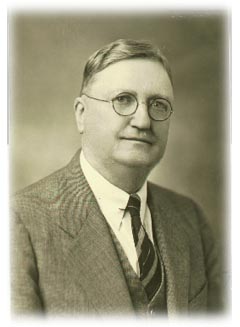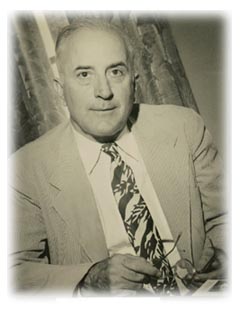| |
Austin College
Presidents
1900 through the AC
centennial |
| |
|
| |
Reverend Thomas Stone
Clyce 1900-1931 |
 |
| |
Thomas Stone Clyce held the longest tenure of any president in Austin
College history. He was born in Kinsgport, Tennessee, September 12, 1863. He received
degrees from King College in Bristol, Tennessee, Columbia Theological Seminary and
Louisville Presbyterian Theological Seminary. Clyce served pastorates in Alabama and
Kentucky before becoming president of Jackson Agricultural College in Jackson, Alabama, in
1896. Upon T. R. Sampson's resignation Clyce came to Austin College in 1900, bringing with
him his wife, May Perrin, a formidable personality herself, who would make major
contributions in the life of the college. During his tenure, Dr. Clyce presided over
numerous changes in the physical plant. By 1910, a dormitory, Luckett Hall, replaced the
wooden shacks that had served as dormitories, a multi-purpose YMCA building was erected, a
fence and grandstand were added to the Athletic Park. Sherman Hall, Thompson Science Hall,
and a powerhouse, later known as Cern Hall, were completed by 1915. By 1922, a new
athletic field was added, and by 1927, a new gymnasium with a basketball court was built
on it. Clyce had great plans for the construction of an administration building to replace
Old Main as well as other projects, but most never came to fruition. Although he oversaw
the groundbreaking, Clyce never saw the administration building progress beyond the
framework erected in 1925. It was finally completed in 1947, the year after his death.
Clyce also presided over important changes in the educational program. New courses in
history, government, physical education, and pedagogy were added, the sciences and modern
languages were expanded, and the traditional classical curriculum received less emphasis.
The faculty grew, and a singing instructor was added for the first time. With the Great
War came military instruction, and, with Dr. Clyce's support, so did coeducation. Clyce's
years as President ended on a series of somber notes. In 1928, his daughter died in an
airplane crash. In 1929, the Great Depression gripped the nation, and in 1930, a race riot
devastated the Sherman community. Clyce retired in 1931, but remained active as President
Emeritus and Professor of Philosophy until his death in 1946. |
| |
|
| |
 |
Everett
Brackin Tucker 1931-1943
|
| |
Everett Brackin Tucker came to the presidency of Austin College on
February 5, 1931, in the very long shadow of Dr. Clyce. Tucker was an educator and devoted
to the cause of education, first and foremost. He was the first layman to hold the office
of President of the College. Tucker was born near Smyrna, Tennessee, April 12, 1881 He was
educated at Vanderbilt University and George Peabody College for Teachers, and received an
LL.D. from Arkansas College in 1925. Tucker brought to Austin College thirty years
experience as an educator, having served as President of Arkansas College, Director of the
Forward Education Movement in Arkansas, Business Manager for the Arkansas Education
Association, and editor of the Journal of Arkansas Education which he founded. Tucker
endured some of the most difficult years Austin College had yet seen. When he assumed his
duties, the College was a quarter million dollars in debt, and the Depression threatened
to close it all together. The coming of World War II decimated enrollment even further,
and in 1939, proposals for merger of Austin College and Trinity began to emanate from the
Presbyterian Synod. The combined struggles divided members of the Synod, the Board of
Trustees, and the administration. Tucker resigned in 1943. Nevertheless, under his
administration, the net worth of the College increased, science, library and dormitory
equipment increased, and a business school and aviation school were added. As part of the
war effort, the College trained over 300 men and women during 1942 through Engineering,
Science, and Management courses sponsored by the United States Office of Education. Tucker
returned to Tennessee where he continued to teach. He was awarded the Austin College
Founders Medal in 1963. |
| |
|
| |
Reverend
William Barnett Guerrant 1944-1953 |
 |
| |
William Barnett Guerrant hailed from Danville, Kentucky. He was an English
major at Centre College in Danville, where he received his Bachelor's and Master's
degrees. He earned a Doctor of Sacred Theology degree from New York City Bible Seminary
and a Doctor of Divinity from King College in Bristol, Tennessee. He served the ministry
for ten years before becoming President of Stonewall Jackson College at Abingdon,
Virginia, from 1927 to 1929. He was Chair of Bible and pastor of the University Church at
Harrogate, Tennessee, and Superintendent of Bachman Memorial School and Home in Farner,
Tennessee, before coming to Austin College in 1939 as Professor of Bible. He served as
acting president in 1943 and his appointment to the presidency was announced during
graduation in 1944. Austin College saw many changes and advances under Guerrant's
administration. In addition to the engineering, science, and management war training
program, Austin College operated a Cadet Nurses training program in cooperation with
Wilson N. Jones Hospital and hosted the Texas Home Guard and the Naval Reserve. In 1943,
the 77th Flight Army-Air Training Corps filled Luckett Hall and part of the Y Building
with Air Corp cadets. Funded by the G.I. Bill, the college provided education to a flood
of returning veterans after World War II, prompting a surge of campus construction, new
courses, and a fifty percent increase in the faculty. The College was admitted to the
Southern Association of Colleges and Secondary Schools; the Administration Building was,
at long last, completed in 1947; Paul Coffin Dormitory for Girls was built in 1948; the
Hughey Gymnasium was erected in 1949; the Student Union and Adams Health Center in 1951. A
department of Fine Arts was added in 1946 and a department of Home Economics in 1952. Also
under Dr. Guerrant, the College celebrated it 100th anniversary. |
| |
|
| |
Back |
next  |


